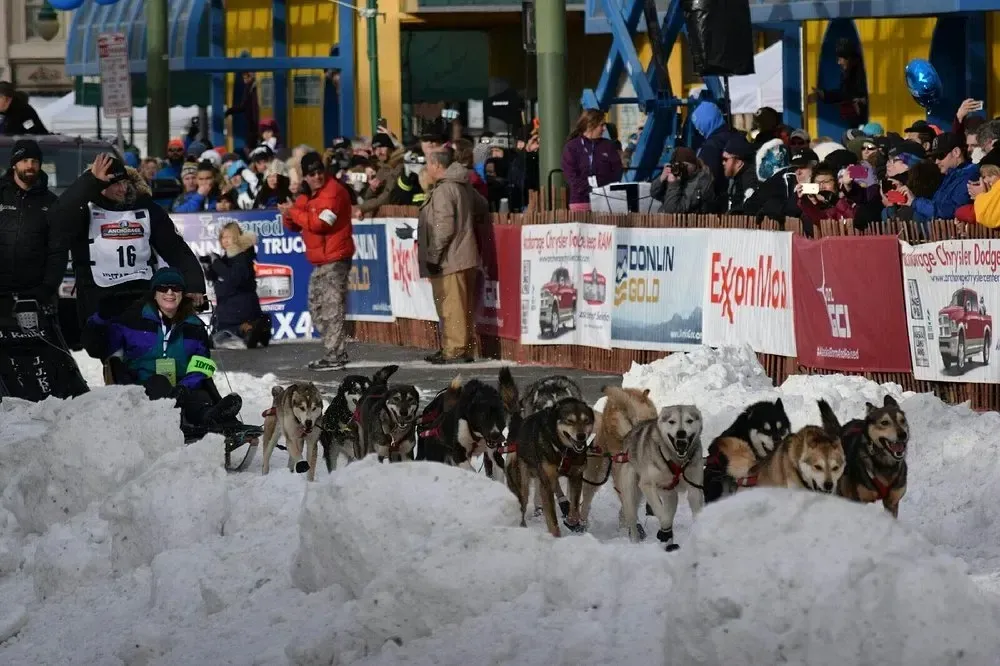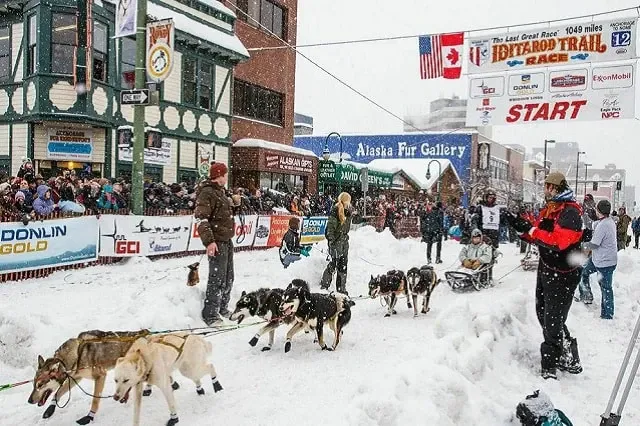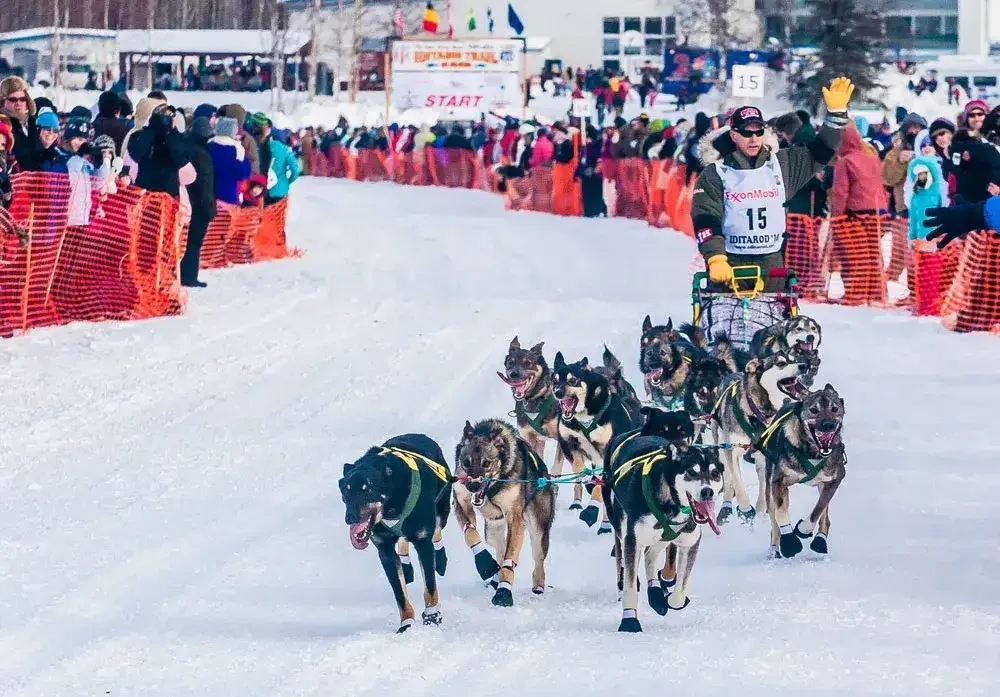Have you ever heard of a race where humans and animals together overcome the harshest limits of nature? A place where courage, perseverance, and the bond between humans and dogs are tested in extreme conditions? That is the Iditarod Trail Sled Dog Race, a unique and world-renowned sporting event held annually in the wilderness of Alaska. More than just a competition, the Iditarod is a cultural icon, an epic tale of conquering nature and the special connection between humans and the mighty Alaskan sled dogs. Join “Du lịch khắp thế gian” (Travel Around the World) to discover all the fascinating things about this legendary Iditarod sled dog race!
Discovering the Iditarod Trail Sled Dog Race
What is the Iditarod Race?
The Iditarod Trail Sled Dog Race, often simply called the Iditarod, is a long-distance sled dog race held annually in early March in Alaska, USA. It’s not just a sporting event; it’s an integral part of Alaskan culture and history. Dubbed “The Last Great Race on Earth,” the Iditarod attracts global attention for its harshness, challenges, and the raw beauty of the Alaskan wilderness.

The race spans over 1,600 km (1,000 miles), traversing diverse and extreme Alaskan terrains, from snow-capped mountains and icy forests to vast glaciers and windswept coastal plains. Teams, consisting of a dog sled driver (musher) and a team of 12 to 16 dogs, must be self-sufficient, facing harsh weather, blizzards, temperatures dropping to -40°C, and hidden dangers from the wilderness.
History and Significance of the Iditarod Race
The Iditarod race is not only a modern sporting event but also carries profound historical significance. The name “Iditarod” comes from a historic trail, the Iditarod Trail, which was a vital transportation route in Alaska in the early 20th century. At that time, sled dogs were the primary means of transport, especially during the harsh winters when roads were frozen.
Origin of the Race: The Iditarod was inspired by the “Great Race of Mercy” in 1925. When a diphtheria epidemic broke out in remote Nome, hundreds of miles from Anchorage, the only available serum was in Anchorage. In blizzard conditions that grounded aircraft, sled dog teams relayed the serum over 1,000 km in record time to Nome, saving the town’s people. This event demonstrated the crucial role of sled dogs and mushers in Alaskan life.
Birth of the Modern Race: The modern Iditarod Trail Sled Dog Race was initiated in 1973 by Dorothy G. Page and Joe Redington Sr. to commemorate the historic Iditarod Trail, honor the role of sled dogs in Alaskan history, and preserve this unique cultural tradition. The first race had a shorter route, but it was later extended to its current distance, recreating the arduous journey of mail carriers and freight transporters on the old Iditarod Trail.
Time and Location of the Iditarod Race
Time: The annual Iditarod festival usually takes place in early March, the transition period between winter and spring in Alaska. The opening ceremony is held on the first Saturday of March in Anchorage. However, the official race start is on the following Sunday in Willow, a small town about 80km north of Anchorage.
Location: Although the opening ceremony is in Anchorage, the official starting point is usually Willow. The final destination is Nome, a town on the Bering Sea coast. The race route can vary each year depending on weather and snow conditions, but it always maintains a starting point near Anchorage and a finish line in Nome.

Reasons for choosing early March:
- Weather Conditions: In early March, Alaskan winter is still present but not as severe as in previous months. Average temperatures range from -20°C to -1°C, cold enough to maintain a thick and firm snowpack, but not too dangerous for the teams.
- Daylight Hours: Daylight hours begin to lengthen in early March, providing more travel time for teams and reducing the risks of traveling in darkness.
- Tradition: March has become the traditional time for the Iditarod since 1973, creating a familiar and anticipated annual rhythm.
The Iditarod race can last from 8 to 15 days or even longer, depending on the speed of the teams and weather conditions along the way. The team that reaches Nome first wins.
The Iditarod Race Route: Overcoming Extreme Challenges
The Iditarod race route is not completely fixed, but there are two main routes used alternately: the Northern Route and the Southern Route. This alternation ensures fairness and diverse experiences for the teams over the years, while also allowing communities along the route to benefit from the event.
Common features of both routes:
- Start: Near Anchorage (usually Willow)
- Finish: Nome
- Length: Approximately 1,049 miles (1,688 km) – the 1,049 miles is chosen to symbolize Alaska being the 49th state of the United States.
- Terrain: Extremely diverse and harsh, including:
- Alaska Range: Towering mountains, steep cliffs, requiring skillful sled dog handling and endurance from both humans and dogs.
- Taiga Forest: Vast coniferous and birch forests, with deep snow and extremely low temperatures.
- Glaciers and Frozen Lakes: Slippery surfaces, risk of ice cracks, demanding caution and experience in navigating icy terrain.
- Bering Sea Coastal Tundra: Vast, windswept plains, often exposed to blizzards and strong gusts of wind.
Checkpoints: Along the route, there are about 20-26 checkpoints, where teams must stop to rest, check the dogs’ health, receive supplies, and interact with organizers and local residents. Checkpoints also provide veterinary services and medical support for teams. Some famous checkpoints include: Rainy Pass, Finger Lake, Unalakleet, White Mountain, and Elim.
Mandatory Rest Stops: To ensure the health of both humans and dogs, the race mandates mandatory rest stops. Each musher must take a total of 24 hours of rest at any checkpoint, an 8-hour rest at the White Mountain checkpoint, and other shorter rest stops. This rest time allows dogs and mushers to recover and prepare for the next legs of the race.
Rules and Extreme Challenges of the Iditarod
Race Rules:
- Teams: Each team consists of one musher and a dog team of 12 to 16 dogs at the start. The number of dogs may decrease during the race due to injury or fatigue, but new dogs are not allowed to be added.
- Equipment: Mushers must carry mandatory equipment, including food for humans and dogs, a first-aid kit, axe, knife, flashlight, compass, sled repair kit, and other essentials for survival in harsh conditions.
- Regulations: The race has strict rules regarding dog care, anti-doping, environmental protection, and fair play. Violations can lead to time penalties or disqualification.
Extreme Challenges:
- Harsh Weather: Blizzards, strong winds, extremely low temperatures, dense fog are frequent weather factors threatening the teams.
- Treacherous Terrain: Mountain climbing, glacier crossings, traversing dense forests, moving on rough, slippery terrain require skillful sled dog handling and excellent physical condition.
- Fatigue and Sleep Deprivation: The race lasts continuously day and night, and mushers face sleep deprivation and both physical and mental fatigue.
- Wildlife Dangers: Bears, wolves, moose, and other wildlife can pose dangers to the teams.
- Dog Care: Ensuring the health and nutrition of the dog team is a major challenge. Mushers must closely monitor the condition of each dog, provide food, water, paw care, and ensure they remain healthy to continue the race.
Culture and Significance of the Iditarod Race
The Iditarod is not just a sporting event; it is also a distinctive cultural event, deeply imbued with the spirit of Alaska.
Symbol of Alaskan Culture: The Iditarod symbolizes the adventurous spirit, courage, perseverance, and adaptability to the harsh nature of the Alaskan people. The race honors the history and tradition of sled dogs, an integral part of Alaskan life and culture.
Community Bonding: The Iditarod creates a strong bond within the Alaskan community. Towns and villages along the race route welcome teams and visitors with enthusiasm, organizing festivals and unique cultural events.
Human-Dog Partnership: The Iditarod is the clearest testament to the special relationship between humans and dogs. The trust, cooperation, and loyalty between musher and dog team are key factors in overcoming the extreme challenges of the race. Alaskan sled dogs are not just talented athletes but also loyal, brave, and resilient companions.
Travel Experiences and Following the Iditarod Race
If you want to experience the vibrant atmosphere and witness this unique event firsthand, traveling to Alaska during the Iditarod is an excellent choice.
Tourism Activities related to the Iditarod:
- Watch the Opening Ceremony in Anchorage: Join the bustling atmosphere of the opening ceremony, admire the parade of teams, and meet famous mushers.
- Follow the Race at Willow (starting point): Witness the moment the teams set off, beginning their Iditarod conquest.
- Visit Checkpoints along the Race Route: Experience the lively atmosphere at checkpoints, observe teams resting, caring for dogs, and preparing for the next leg. Some easily accessible checkpoints for tourists are Willow, Talkeetna, Wasilla.
- Visit the Iditarod Trail Headquarters Museum: Learn more about the history, culture, and fascinating stories related to the Iditarod race.
- Experience Indigenous Culture: Explore the culture and customs of Alaskan natives, visit traditional villages, and enjoy local cuisine.
- Join Specialized Tour Packages: Alaskan tour companies like Premier Tour offer all-inclusive or customized tours, bringing you closer to the Iditarod race and exploring the pristine beauty of Alaska.

Travel Tips for the Iditarod:
- Book Tours and Accommodation Early: The Iditarod period is peak tourist season in Alaska, so book tours, flights, and hotels months in advance to ensure availability and good prices.
- Prepare Warm Clothing: The weather in Alaska in March is still very cold, so prepare warm clothes, waterproof shoes, gloves, hats, and scarves to keep warm.
- Learn about Local Culture and Customs: Show respect for Alaskan culture and people.
- Bring a Camera and Binoculars: Capture memorable moments of the race and admire the majestic natural beauty of Alaska.
- Explore Tour Options: For a complete and well-supported Iditarod experience, consider specialized tours from reputable companies like Premier Tour.
Conclusion
The Iditarod Trail Sled Dog Race is not just an adventurous sporting event but also a journey of discovering culture, history, and the indomitable spirit of humans and animals. It is a fantastic opportunity to experience the pristine beauty of Alaska, immerse yourself in the vibrant festival atmosphere, and witness inspiring stories of courage, perseverance, and friendship overcoming all challenges. Come to Alaska and discover the legendary Iditarod race, a unique and unforgettable travel experience!
Premier Tour – Specializing in Unique Tours Worldwide
Website: https://premiertour.com.vn/ Hotline: (028) 7777 2225 – 0768 586 856 Address: 43 Le Thi Hong Gam, Nguyen Thai Binh Ward, District 1, Ho Chi Minh City Fanpage: https://www.facebook.com/premiertourdocla/